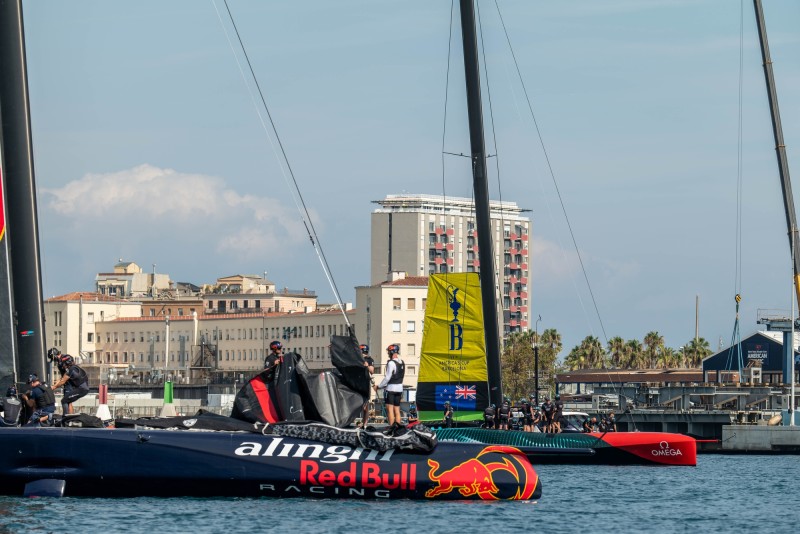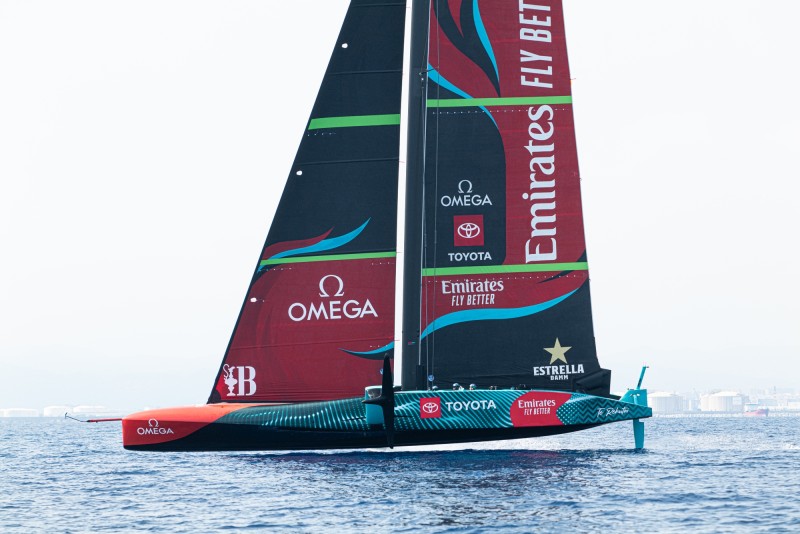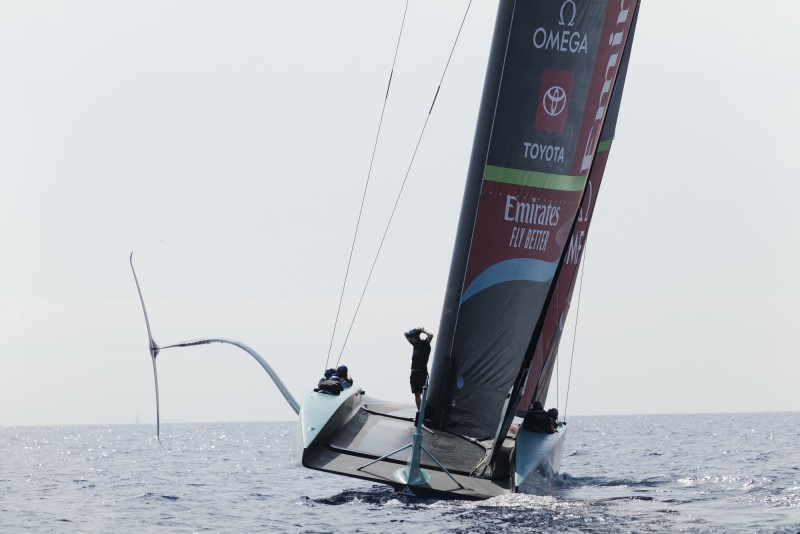
©Paul Todd/America’s Cup
America's Cup, sailing the AC75s in marginal lower wind range
One of the most technically demanding days on the water for both Emirates Team New Zealand and Alinghi Red Bull Racing both sailing their AC75s in marginal lower wind range conditions that called for judgement, accuracy and prefect symbiosis between the helms and the trim teams to keep power-on and the boats flying.
Both teams looked to take a lot out of day whose forecast didn’t look promising but as the wind built slowly into the afternoon, it became one of those perfect Barcelona sessions that neither team will have wanted to finish.
For Alinghi Red Bull Racing, the shore team towed out for some 15 miles up north-east along the coastline beyond the rather pretty town of Mataró where a breeze line was spotted. It was a good call by the meteorologists who timed the run to perfection and gave the Swiss sailors the absolute best of the day as they brought BoatZero back along the coastline at pace and with a newfound confidence building into their light airs performance. A stern up mode induced with notably high forward rudder rake gives the clearance required to keep the stern run-off area high and out of displacement quickly whilst the bow-down mode, both upwind and downwind, is ‘a la mode’ in the 37th America’s Cup and looked rapid and stable.

Arnaud Psarofaghis and Maxime Bachelin, who are becoming a really effective driving team with a lot of trust and belief in each other, drove accurately with noticeable scallops as they rode from puff to puff. The only cause for concern were the gybes downwind going from starboard onto port gybe with the boat transitioning from the flatter Emirates Team New Zealand foils to the viciously anhedral American Magic foils. There’s a very good reason why the consensus on foil design in this cycle, as we’ve seen on the LEQ12 boats and the modified AC40s, is towards long, flat span, slight anhedral foils and it’ll be a surprise if come next year we don’t see these feature heavily on the new AC75s.
As the breeze built, so did Alinghi Red Bull Racing’s confidence and as they approached the Barcelona racecourse area, they were flying and playing around with modes, roll-gybing and playing with leeward heel ahead of manoeuvres to almost stand on the foils to give maximum momentum. On balance it was a profitable day for the Swiss who have determinedly worked through the BoatZero re-commissioning period after over a month in the shed as they concentrated on their AC40 preparations.
Speaking afterwards, Nicolas Rolaz part of the Driving Team for Alinghi Red Bull Racing and an undoubted star of the future gave a good summary of the sailing saying: “It was a big struggle today to find some good breeze locally. After a long tow we managed to get into a nice breeze focusing obviously on finding the best trims for take-offs and straight-line always trying to perform…we're still looking for the best setup to fly BoatZero and it's always nice to check some different bow attitudes and see how the boat behaves…we had some struggles with the gybes, I think it's just because we're trying a new technique and obviously with this light breeze it doesn't make the thing easy and towards the end the wind was just dying so it was even harder.”
Emirates Team New Zealand meanwhile, docked-out at the same time as Alinghi Red Bull Racing but with a very different schedule set by uber coach Ray Davies. For the Kiwis it was all about aero modes today and Pete Burling was up and out of his steering pod on multiple occasions, standing on the aft deck and looking intently up at the leech settings and the break all the way down to the traveller. Plenty of work going on with the skins of the sails but the focus appeared to be the effect on the top of the sail with even Nathan Outteridge out of his pod, sitting on deck and taking shots upwards.

The effect though of the Kiwis sail work is a very smooth flight in the light with Blair Tuke and Andy Maloney calling the puffs in to perfection and executing real judgement on the depth inducing mast rotation and the traveller control whilst keeping the jib leech tension relatively tight and the jib track high towards the centreline. Gybing ‘Te Rehutai’ in the light is starting to feel like poetry in motion with desperately late board drops combined with over-sheeting of the mainsail track above the centre-line before ever deeper exits. These are gains being made in abundance by the Kiwis.
Speaking after sailing, Ray Davies was pleased with the team’s efforts saying: “It's really nice when you have conditions like this where you can scroll through a lot of the tests and (get the) information we're trying to learn. We had a lot of the time in quite light conditions which is invaluable really to have that much time in the bottom end conditions, normally the breeze is sort of building or is not quite enough so it was a really, really, good day for that.”
Talking about the development work that this devastatingly innovative team are working on, Ray added: “We're obviously moving towards what we think the future is so yeah there's a lot of stuff that no one will ever know we're doing until after the Cup so just working hard for making these incremental gains that should all add up to being something significant compared to where we were last time, so there’s a lot of work to get all of the different areas we're working on to come together, to work together, so we're getting there.”
And giving on overview of the state of play in the America’s Cup, Ray offered: “We’re positive everyone must be under construction now, so they’re definitely locked in on hull shapes and designs and structure and all of that, so I think, it's impossible to know, but I think most teams are within a couple of months of each other's launch date. I'd imagine but I think you don’t want to launch too early because they're missing out on development time and obviously you can't go too late because you run a risk of not being ready, so I think we'll all be popping boats out three or four months before the Cup.”

With the team returning to New Zealand after the Preliminary Regatta in Jeddah, Saudi Arabia, Ray confirmed that the AC75 will stay in Barcelona whilst the team will train on the team’s two AC40’s in Auckland and their new AC75 into the antipodean summer. Will they miss Barcelona conditions? Ray was unequivocal: “Not really. I think it's going to be quite different. I think come November you sort of flick a switch, daylight savings kicks in and it starts getting dark a lot earlier, conditions are very different to what we see in September and October so I don't think we're going to be missing out on too much there.”





